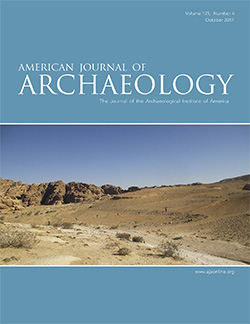AJA Open Access
BY-NCOctober 2017 (121.4)
Book Review
Rural Archaeology in Early Urban Northern Mesopotamia: Excavations at Tell al-Raqa’i
Edited by Glenn M. Schwartz
Reviewed by Nicola Laneri
For a long time, archaeological research in ancient Mesopotamia has been focused on the excavation and interpretation of large urban centers. However, because of a paucity of funds and especially because of the numerous rescue projects linked to the construction of river dams by the local governments in Syria, Turkey, and Iraq during the last 30 years, archaeologists have shifted their attention to small centers, rural areas, and the investigation of the use and transformation of ancient landscapes. An example is the work carried out on the small (0.46 ha, 6 m high) site of Tell al-Raqa’i located in northeastern Syria along the middle section of the Khabur River, an affluent of the Euphrates. The project’s recently published final report detailing the excavation is the subject of this review.
This volume brilliantly presents the results of the archaeological work directed by Schwartz and Hans Curvers between 1986 and 1993. They unearthed five occupation levels; level 1 dated to the Hellenistic period, and levels 2–5 from the early to the mid third millennium B.C.E. Research was directed toward interpreting the data collected from the earliest levels and especially to the study of “a small community from the period of the formation of complex societies in northern Mesopotamia and Syria” (i.e., the third millennium B.C.E.) (2). Thus, after an introduction to the Tell al-Raqa’i project (ch. 1), in which the project’s research agenda is clearly stated, chapter 2 provides a detailed analysis of the stratigraphic sequence and the excavated contexts. Even though this chapter presents a clear analysis of the architecture unearthed in each layer, useful to the reader would have been a chronological chart that highlighted the different phases, provided comparable chronological sequences at other northern Mesopotamian sites (e.g., the Associated Regional Chronologies for the Ancient Near East [ARCANE] chronological sequence), and cited, where available, absolute dates from each level. Chapters 2 and 3 highlight how the small settlement was transformed throughout the third millennium B.C.E. Tell al-Raqa’i is marked by an initial settlement (early third millennium B.C.E.) with very simple grill architecture (level 5), followed by the construction of a large building (the Round Building) enclosed by a thick, nearly circular mudbrick wall characterized by corbel-arched doorways delineating some passageways and, most importantly, by the presence of numerous silos and platforms used for processing and storing grain (level 4). Level 3 consists of a small (ca. 0.21 ha) village with different neighborhoods (two domestic sectors with two-room houses, an “industrial” area dedicated to specialized craft activities, and a cultic area marked by a separate precinct with a small one-room temple with a stepped altar) and continuity in the use of the Round Building. Level 2, in contrast, represents a phase of less complex spatial organization characterized by numerous child burials on the fringes of the site.
According to Schwartz, the transformation in the settlement’s organization during the level 4 and 3 periods is part of a broader phenomenon of economic specialization and social stratification that connects the site (and the whole middle Khabur region) with the social complexity recognizable in the urban centers of northern Mesopotamia. Such an interpretation is supported by an increase in the production of wheelmade fine and medium wares between levels 5 and 2 and a corresponding decrease in handmade pottery (ch. 4), as well as by the increasing presence of administrative tools (seals, seal impressions, tokens, sealings, and numerical tablets), objects associated with textile production, wall paintings (ch. 5), metal artifacts (ch. 8), and Canaanean blades, which indicate long-distance commercial exchange, probably with communities located in southeastern Anatolia (ch. 7). The ecofactual data (chs. 9, 10) also testify to an increase in specialization in the subsistence strategies of the communities inhabiting the small site of Tell al-Raqa’i throughout the first half of the third millennium B.C.E.; as correctly pointed out by Schwartz in the conclusions (ch. 11), “the specialized focus on barley and on sheep/goat pastoralism are the clearest pieces of evidence indicating that major change had occurred in the lives of the people living in this small community,” with a “shift from a broad-based subsistence strategy to a specialized economy” (631). However, the 38 graves dated to the third-millennium B.C.E. phases (ch. 6) do not show clear elements of social stratification, especially regarding level 3 (479). One explanation may be that the intramural burials of this phase represent only part of the population, and the main areas used for deposition of the dead were not identified during the research. An alternative is a reduced level of social complexity in the organization of the third-millennium B.C.E. village community of Tell al-Raqa’i.
The conclusion engages readers in a debate on the role of third-millennium B.C.E. small sites featuring granaries in the middle Khabur region. Schwartz presents his “export” hypothesis (i.e., sites were locales for storing and processing grain under the supervision of elite groups located in major northern Mesopotamian urban centers as part of a complex system of staple finance) along with the alternative interpretations of other scholars who instead suggest local accumulation of surplus as part of a “communal” storehouse for the whole village without the necessity of involving exogenous urban elites. Numerous archaeological indicators presented in the volume, however, support its authors’ interpretation of social complexity in rural northern Mesopotamia and the presence of an elite controlling the organization of the village of Tell al-Raqa’i during the third millennium B.C.E.
In summary, this volume offers an extraordinary example of successful communication of the final results of an archaeological project through initial presentation of the collected data, followed by a theoretical reinterpretation of models previously outlined in preliminary reports.
Nicola Laneri
School of Religious Studies
Center for Ancient Mediterranean and Near
Eastern Studies (CAMNES)/Istituto Lorenzo de’ Medici
nicola.laneri@camnes.org
